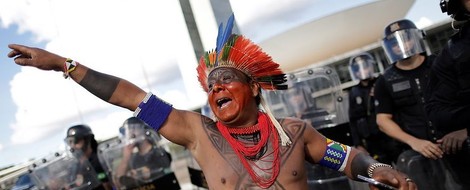Your podcast discovery platform
Curious minds select the most fascinating podcasts from around the world. Discover hand-piqd audio recommendations on your favorite topics.

piqer for: Climate and Environment
Pamela works as a Press & Communications Manager for an international NGO (IWGIA) defending indigenous peoples' rights. She holds an Erasmus Mundus MA in Journalism, Media & Globalisation from Hamburg and Aarhus University and an MA in Political Science from the University of Buenos Aires. She will be putting the eye on international media coverage of indigenous communities and their demands.
Brazil: Land Demarcation Is The Last Bastion For Indigenous Peoples
While at UN headquarters in New York member states and more than 1,000 indigenous representatives marked the 10th Anniversary of the Declaration on Indigenous Peoples' Rights (UNDRIP), Brasilia exploded under an indigenous protest demanding territorial rights.
One of the huge gaps in international law is the implementation of the declaration granting indigenous peoples around the globe collective rights to their ancestral lands. Many would think this gap has nothing to do with the debate on how to protect the environment, but it does to a great extent. According to indigenous organisation Consejo Indigenista Misionero (CIMI), only in the last 13 years, 900 indigenous leaders were killed for defending their access to land and resources across the country.
Even though much is done in the international arena, governments still avoid meeting their commitments. In the midst of a deep economic crisis, Brazil is showing a political stand for hunting for profits instead of protecting the rights of indigenous communities, who nationally represent 900,000 people legally owning 12.2 % of Brazil's territory.
Land rights: A ticking bomb handled with violence
Again and again, research has shown that indigenous communities are the best keepers of natural environments. Though, they fight against the big dogs (farmers, a racist government and extractive industries) with nothing else to lose.
With a government that turns its back to their demands for justice, indigenous peoples took their complaints to the Congress early this week. To show what this political decision means for them, they staged a massive funeral in front of the eyes of parliamentarians. Once again, they were met with violence. The military decided to retaliate with tear gas, rubber bullets, and pepper spray.
The photo reportage clearly depicts how and why indigenous peoples are fighting for the most basic element of their existence: their land.
